Injection Barrel/Nozzle/Mold-Cavity Scientific Real-Time Sensing and Molding Quality Monitoring for Different Polymer-Material Processes
Abstract
:1. Introduction
2. Materials and Methods
2.1. Real-Time Sensing Design and Preparation
- The sensor installed on the barrel and the nozzle acts directly on the diaphragm of the sensor through the pressure of a medium, causing the diaphragm to produce a slight displacement proportional to the pressure of the medium, thereby changing the resistance of the sensor and detecting it with its electronic circuit. It converts and outputs a corresponding pressure signal, which is also the value of the melting pressure required for this study (barrel and nozzle).
- As for the mold-cavity, it is a button-type sensor installed inside the mold-cavity. The pressure-sensing source comes from the ejector-pin in the mold. When the melt flows through the ejector-pin, a small displacement proportional to the medium pressure is also generated, which then causes the resistance of the sensor to change; the change detected by its electronic circuit, converted, and output as a corresponding pressure signal, which is also the melt pressure value in the mold-cavity required for this research.
- The non-linear error values of the above sensor are all 1.0 %F.S; and the available pressure range (maximum value) and material are (i) barrel and nozzle of 5~2100 bar and the material of Inconel-718 and (ii) mold-cavity of 5~800 bar and the material of SUS-630.
2.2. Molding Material and Its Equipment
2.3. Characterizations
- In order to grasp the change of melting pressure during the injection molding process, the melt pressure was measured using the barrel, nozzle, and mold-cavity pressure sensor, and the pressure peak was measured at maximum pressure (Figure 7).
- The shrinkage part of the finished product was measured using a 3D optical measurement system (3D-OMS; ATOS Core 185 manufactured by Road-Ahead-Technologies Consult-ant Corp.; Taichung City, Daya District, Taiwan); the measurement range is 185 mm × 140 mm, the working distance is 250 mm, the charge-coupled device pixel is 12 million, and the measurement accuracy ±5%. The actual molding characteristics of the 3D-OMS will be used to measure the roundness (shrinkage characteristics) of the molded product and correlate it with the viscosity index. We carried out the radial measurement on a circular-part, which is divided into 8-point straight-line measurements, and Equation (2) was used to calculate the roundness variations (Figure 8).
3. Results
3.1. Effects of Material Variation and Melt-Fluidity Properties
- 1.
- Melting Pressure and Its Relevance to Viscosity Index
- 2.
- Melt-fluidity and Its Effect of Quality Characteristics
3.2. DOE and Its Correlation-Analysis of Quality Characteristics
- 1.
- Screw Speed Variation
- 2.
- Back Pressure Variation
- 3.
- Melt Temperature Variation
- 4.
- Injection Speed Variation
- 5.
- V/P Switch-over Position Variation
4. Conclusions
- 1.
- Through the use of a real-time pressure measurement system, we were able to successfully grasp the pressure history and the trend changes in the viscosity index of the melt from the plasticization to the injection process (injection barrel to the mold-cavity).
- 2.
- A 3D-OMS analysis which integrates the actual molding characteristics of the injection machine by sensing information was successfully used to measure the roundness (shrinkage characteristics) of the sample and compare it with the melt pressure-peak and viscosity index.
- 3.
- Real-time melt pressure-peak (viscosity index) information collected from sensors during the injection molding process can be used as a characteristic value of adaptive process-control for scientific injection molding.
Author Contributions
Funding
Institutional Review Board Statement
Informed Consent Statement
Data Availability Statement
Conflicts of Interest
References
- Tsai, M.-H.; Fan-Jiang, J.-C.; Liou, G.-Y.; Cheng, F.-J.; Hwang, S.-J.; Peng, H.-S.; Chu, H.-Y. Development of an Online Quality Control System for Injection Molding Process. Polymers 2022, 14, 1607. [Google Scholar] [CrossRef] [PubMed]
- Su, C.-W.; Su, W.-J.; Cheng, F.-J.; Liou, G.-Y.; Hwang, S.-J.; Peng, H.-S.; Chu, H.-Y. Optimization process parameters and adaptive quality monitoring injection molding process for materials with different viscosity. Polym. Test. 2022, 109, 107526. [Google Scholar] [CrossRef]
- Fan-Jiang, J.-C.; Su, C.-W.; Liou, G.-Y.; Hwang, S.-J.; Lee, H.-H.; Peng, H.-S.; Chu, H.-Y. Study of an Online Monitoring Adaptive System for an Injection Molding Process Based on a Nozzle Pressure Curve. Polymers 2021, 13, 555. [Google Scholar] [CrossRef] [PubMed]
- Zhou, X.; Zhang, Y.; Mao, T.; Zhou, H. Monitoring and dynamic control of quality stability for injection molding process. J. Mater. Process. Technol. 2017, 249, 358–366. [Google Scholar] [CrossRef]
- Chen, Y.-S.; Wu, K.-T.; Tsai, M.-H.; Hwang, S.-J.; Lee, H.-H.; Peng, H.-S.; Chu, H.-Y. Adaptive process control of the changeover point for injection molding process. J. Low Freq. Noise Vib. Act. Control. 2019, 40, 383–394. [Google Scholar] [CrossRef] [Green Version]
- Ponçot, M.; Addiego, F.; Dahoun, A. True intrinsic mechanical behaviour of semi-crystalline and amorphous polymers: Influences of volume deformation and cavities shape. Int. J. Plast. 2013, 40, 126–139. [Google Scholar] [CrossRef]
- Ponçot, M. Comportements Thermomécaniques de Polymères Chargés Selon Différents Chemins de Déformation et Traitements Thermiques. Ph.D. Thesis, INPL, Nancy, French, 2009. [Google Scholar]
- Ponçot, M.; Martin, J.; Hiver, J.M.; Verchère, D.; Dahoun, A. Study of the dimensional instabilities of laminated polypropylene films during heating treatments. J. Appl. Polym. Sci. 2012, 125, 3385–3395. [Google Scholar] [CrossRef]
- Ponçot, M.; Martin, J.; Hiver, J.M.; Dahoun, A.; Bourson, P.; Godard, O. Mécanismes de déformation plastique en traction et cisaillement de PET amorphe extrude. Matériaux Tech. 2011. in press. Available online: https://hal.archives-ouvertes.fr/hal-00596311 (accessed on 30 January 2020).
- Galeski, A.; Rozanski, A. Cavitation during Drawing of Crystalline Polymers. Macromol. Symp. 2010, 298, 1–9. [Google Scholar] [CrossRef]
- Malinowski, H. The APC of Injection Molding APC Adaptive Process Control; KraussMaffei Technologies: München, Germany, 2015. [Google Scholar]
- Kazmer, D.O.; Velusamy, S.; Westerdale, S.; Johnston, S.; Gao, R.X. A comparison of seven filling to packing switchover methods for injection molding. Polym. Eng. Sci. 2010, 50, 2031–2043. [Google Scholar] [CrossRef]
- Chen, J.Y.; Zhuang, J.X.; Huang, M.S. Monitoring, prediction and control of injection molding quality based on tie-bar elongation. J. Manuf. Process. 2019, 46, 159–169. [Google Scholar] [CrossRef]
- Chen, J.-Y.; Liu, C.-Y.; Huang, M.-S. Enhancement of Injection Molding Consistency by Adjusting Velocity/Pressure Switching Time Based on Clamping Force. Int. Polym. Process. 2019, 34, 564–572. [Google Scholar] [CrossRef]
- Chen, J.-Y.; Hung, P.-H.; Huang, M.-S. Determination of process parameters based on cavity pressure characteristics to enhance quality uniformity in injection molding. Int. J. Heat Mass Transf. 2021, 180, 121788. [Google Scholar] [CrossRef]
- Huang, M.; Nian, S.; Lin, G. Influence of V/P switchover point, injection speed, and holding pressure on quality consistency of injection-molded parts. J. Appl. Polym. Sci. 2021, 138, 51223. [Google Scholar] [CrossRef]
- Huang, M.S.; Liu, C.Y.; Ke, K.C. Calibration of cavity pressure simulation using autoencoder and multilayer perceptron neural networks. Polym. Eng. Sci. 2021, 61, 2511–2521. [Google Scholar] [CrossRef]
- Huang, M.S.; Ke, K.C.; Liu, C.Y. Cavity pressure-based holding pressure adjustment for enhancing the consistency of injection molding quality. J. Appl. Polym. Sci. 2021, 138, 50357. [Google Scholar] [CrossRef]
- Ke, K.-C.; Huang, M.-S. Quality Classification of Injection-Molded Components by Using Quality Indices, Grading, and Machine Learning. Polymers 2021, 13, 353. [Google Scholar] [CrossRef] [PubMed]
- Chen, J.-Y.; Liu, C.-Y.; Huang, M.-S. Tie-Bar Elongation Based Filling-To-Packing Switchover Control and Prediction of Injection Molding Quality. Polymers 2019, 11, 1168. [Google Scholar] [CrossRef] [PubMed] [Green Version]
- Zhou, X.; Zhang, Y.; Mao, T.; Ruan, Y.; Gao, H.; Zhou, H. Feature extraction and physical interpretation of melt pressure during injection molding process. J. Mater. Process. Technol. 2018, 261, 50–60. [Google Scholar] [CrossRef]
- Kamal, M.R.; Varela, A.E.; Patterson, W.I. Control of part weight in injection molding of amorphous thermoplastics. Polym. Eng. Sci. 1999, 39, 940–952. [Google Scholar] [CrossRef]
- Chen, J.-Y.; Yang, K.-J.; Huang, M.-S. Online quality monitoring of molten resin in injection molding. Int. J. Heat Mass Transf. 2018, 122, 681–693. [Google Scholar] [CrossRef]

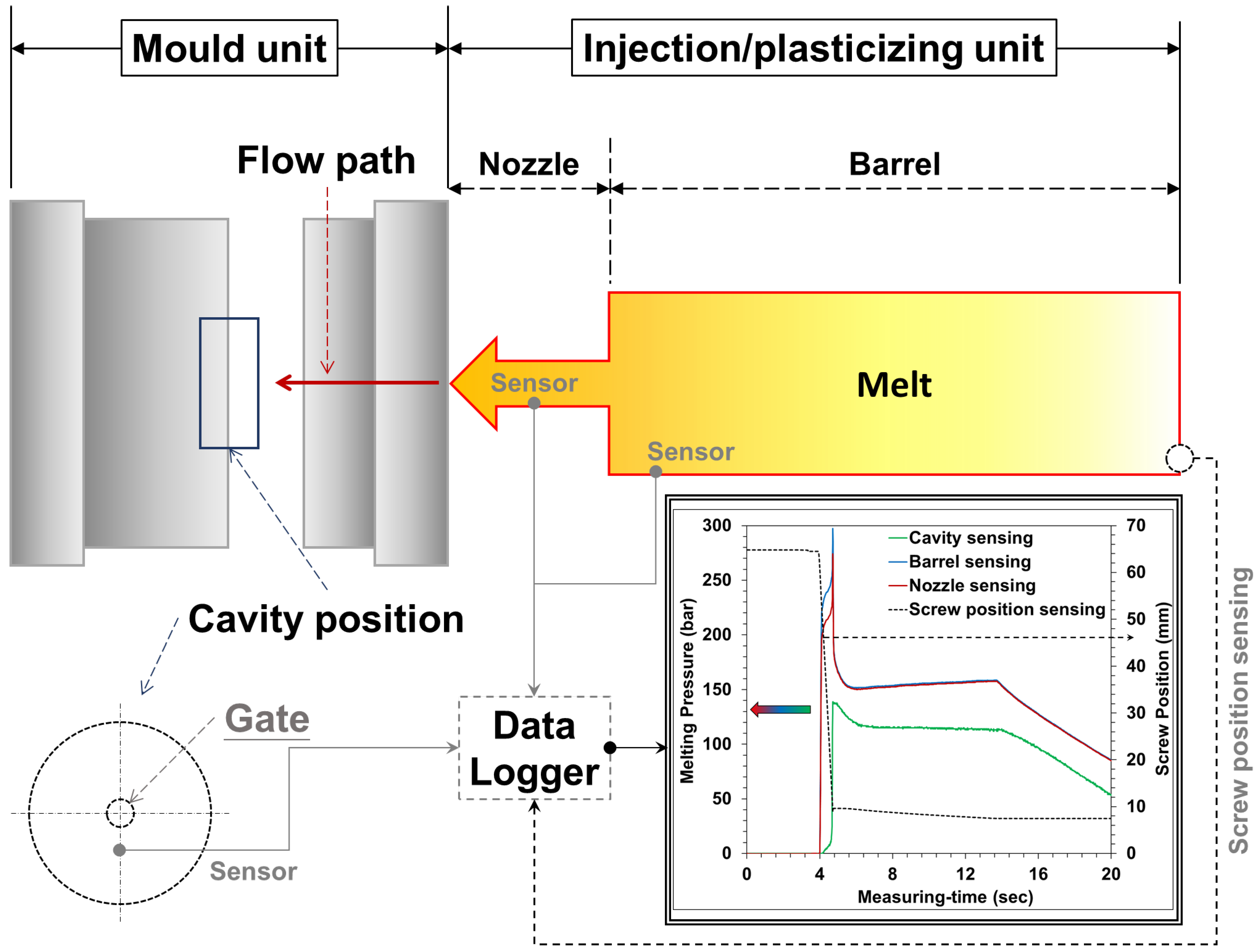
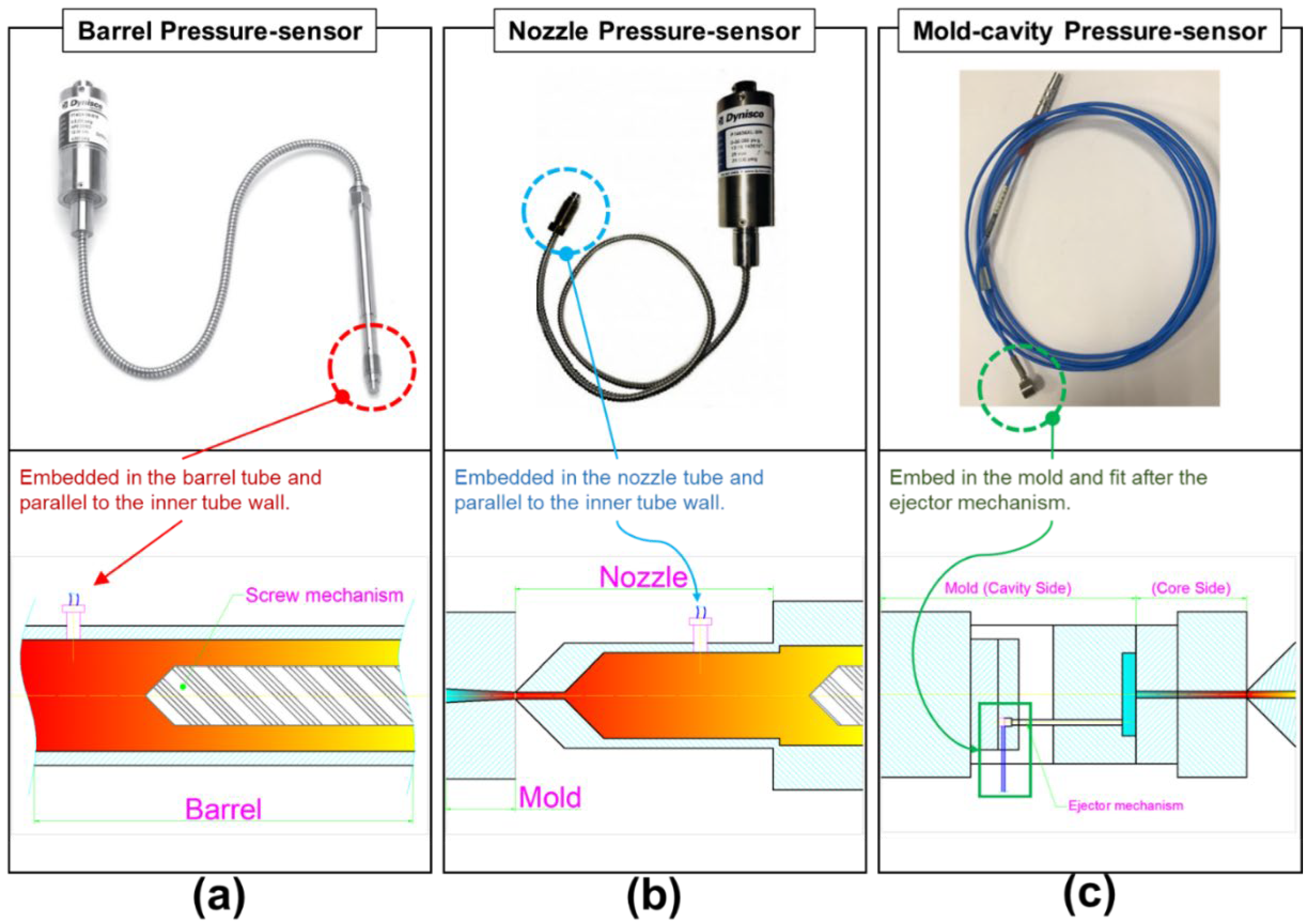
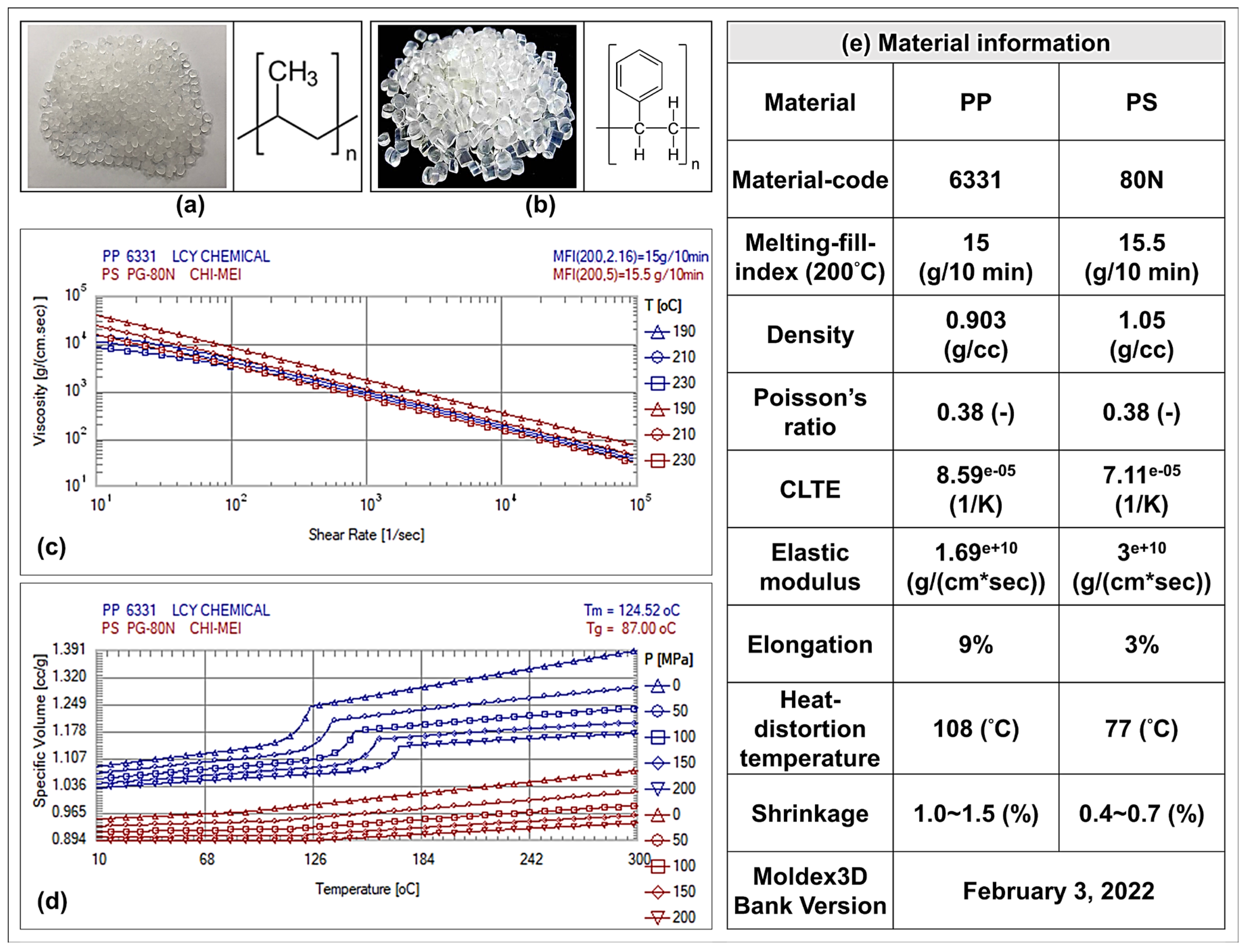
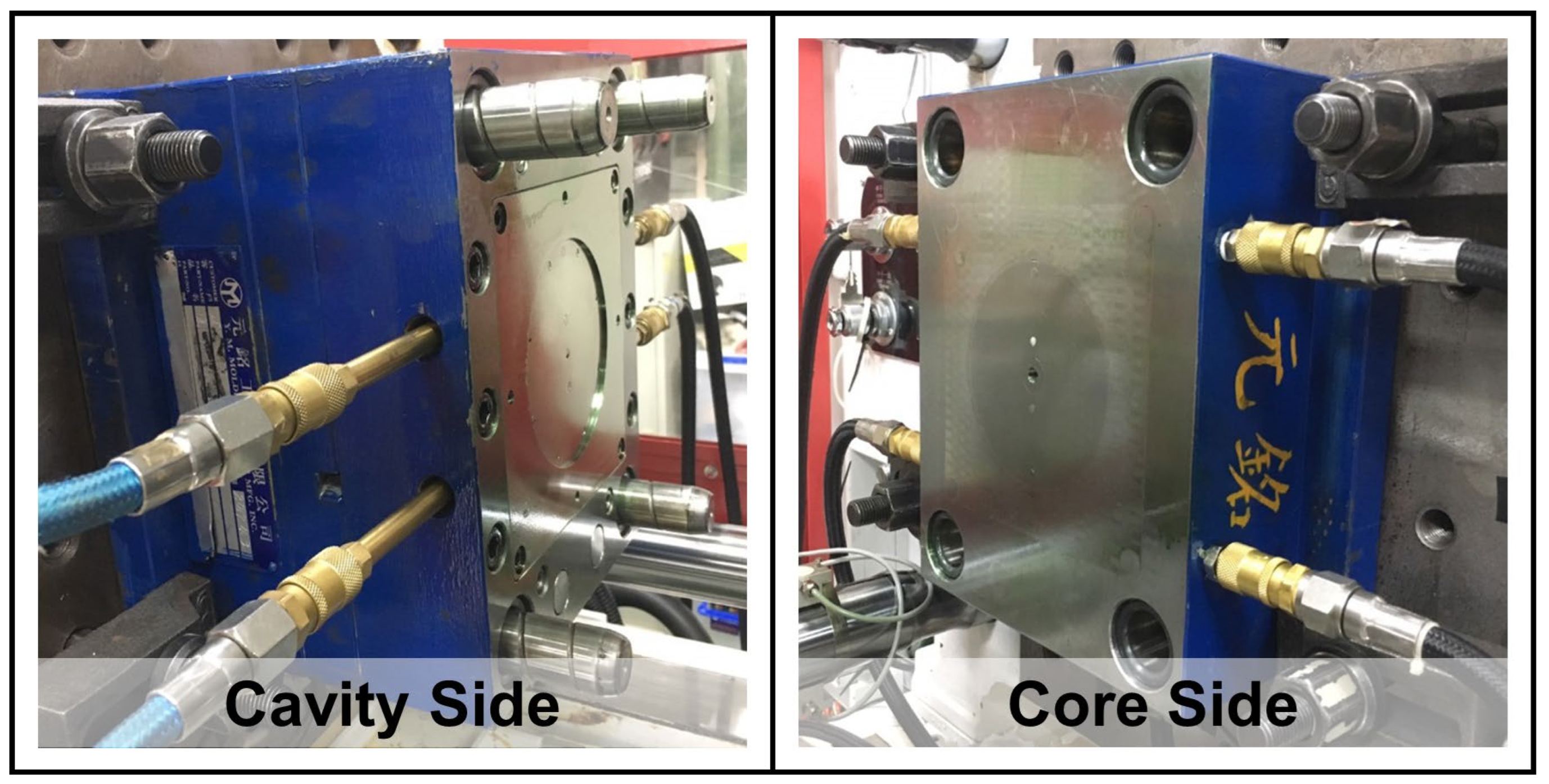
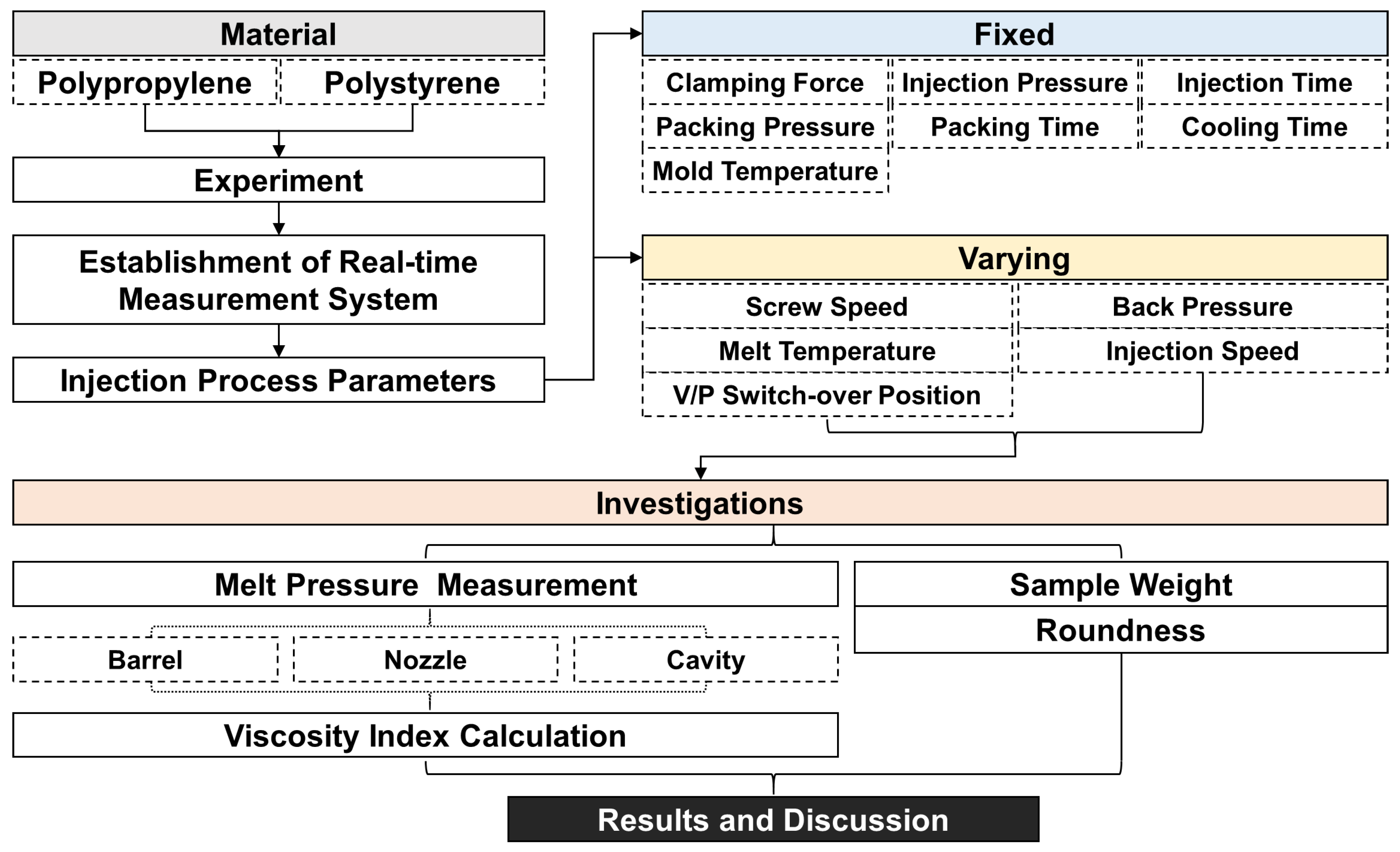

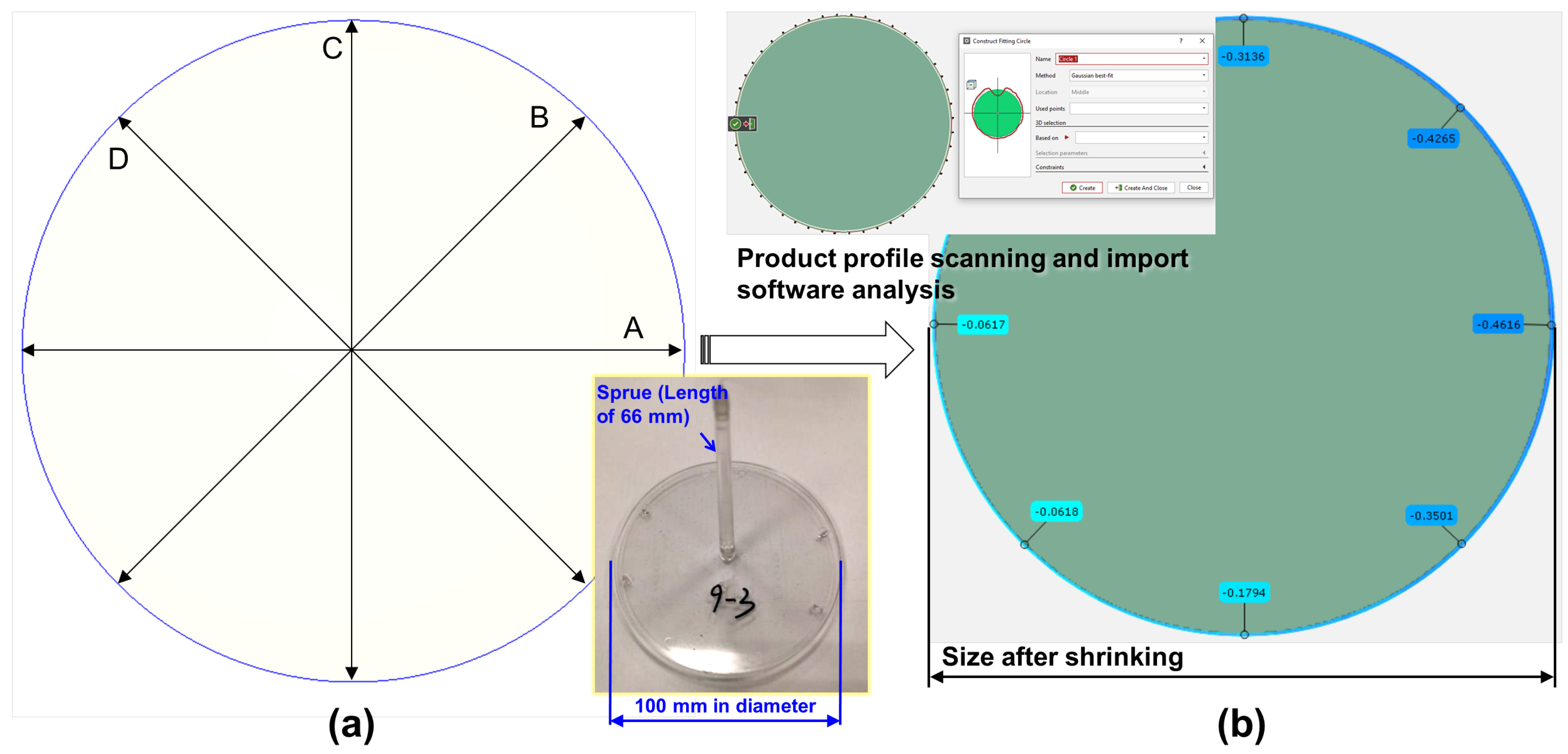
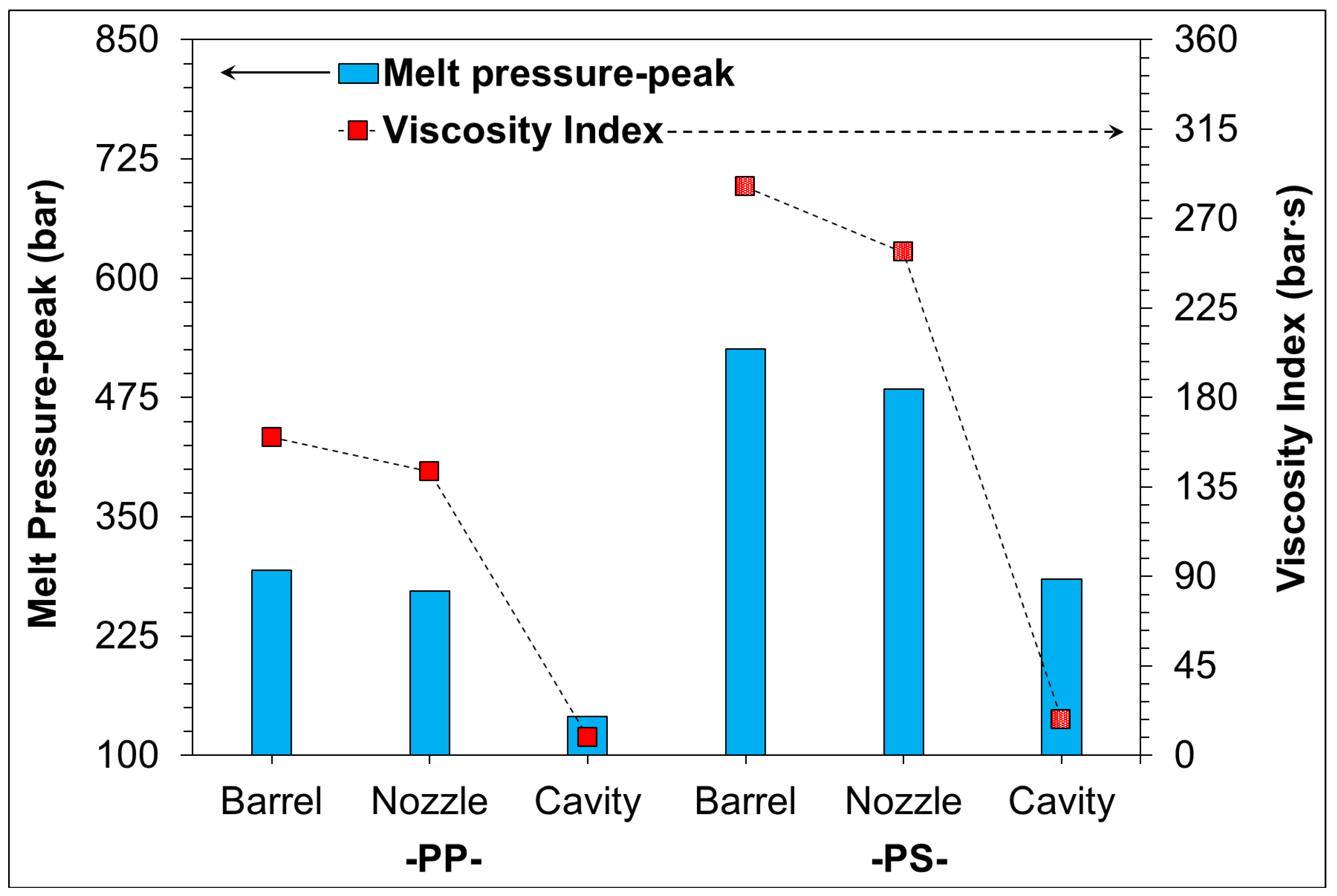

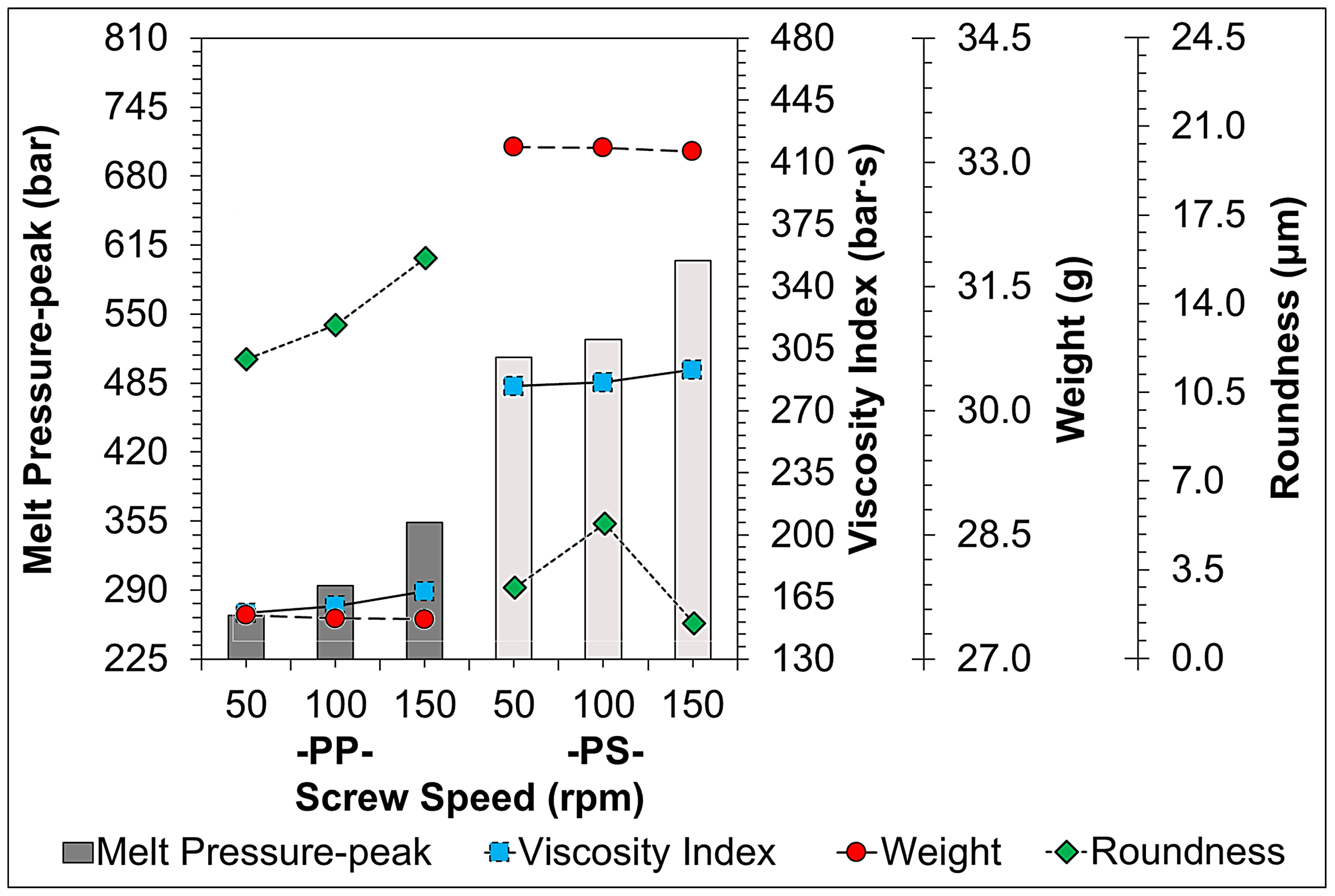
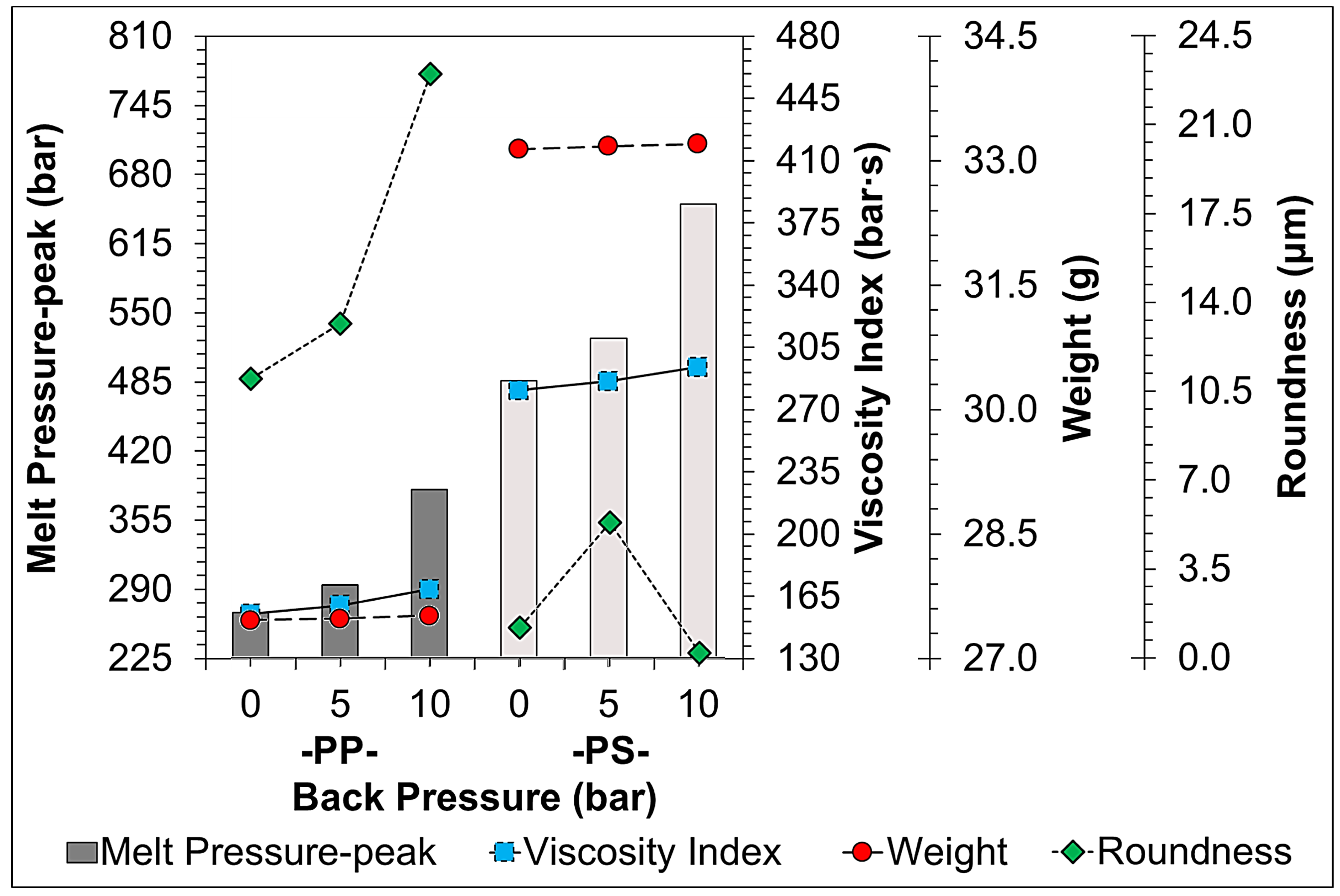
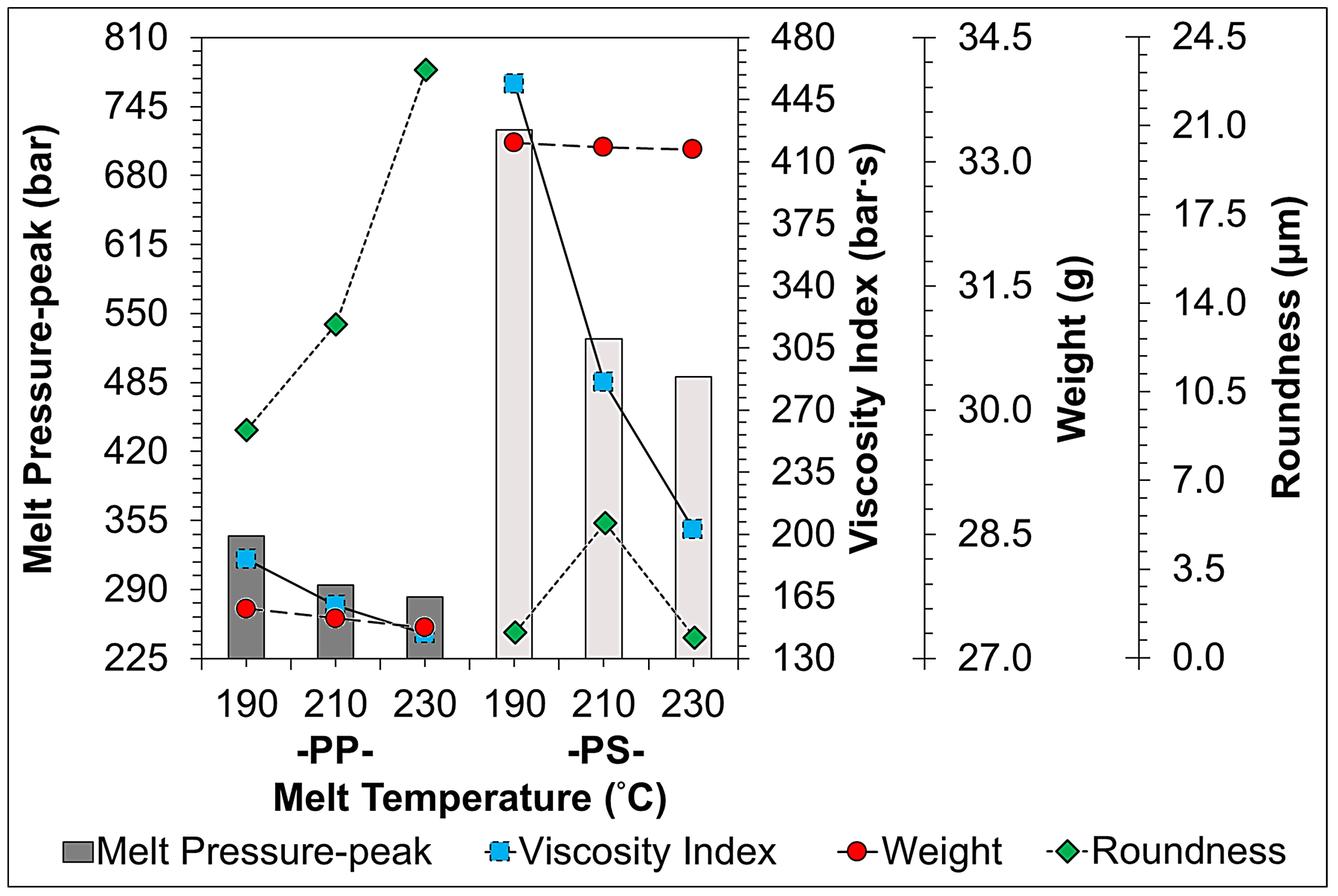


| Factors (Set Value) Maintained Constant | Controllable Factors | ||||
|---|---|---|---|---|---|
| Clamping Force (ton) | 45 | Screw Speed (rpm) | 50 | 100 | 150 |
| Mold Temperature (°C) | 60 | Back Pressure (bar) | 0 | 5 | 10 |
| Cooling Time (s) | 40 | Melt Temperature (°C) | 190 | 210 | 230 |
| Injection Pressure (bar) | 170 | Injection Speed (mm/s) | 40 | 70 | 100 |
| Injection Time (s) | 1.5 | V/P Switch-over Position (mm) | 8 | 10 | 12 |
| Packing Time (s) | 10 | ||||
| Packing Pressure (bar) | 10 | ||||
| Exp. | Screw Speed (rpm) | Back Pressure (Bar) | Melt Temperature (°C) | Injection Speed (mm/s) | V/P Switch-Over Position (mm) |
|---|---|---|---|---|---|
| 1 | 50 | 5 | 210 | 50 | 10 |
| 2 | 100 | 5 | 210 | 50 | 10 |
| 3 | 150 | 5 | 210 | 50 | 10 |
| 4 | 100 | 0 | 210 | 50 | 10 |
| 5 | 100 | 5 | 210 | 50 | 10 |
| 6 | 100 | 10 | 210 | 50 | 10 |
| 7 | 100 | 5 | 190 | 50 | 10 |
| 8 | 100 | 5 | 210 | 50 | 10 |
| 9 | 100 | 5 | 230 | 50 | 10 |
| 10 | 100 | 5 | 210 | 40 | 10 |
| 11 | 100 | 5 | 210 | 70 | 10 |
| 12 | 100 | 5 | 210 | 100 | 10 |
| 13 | 100 | 5 | 210 | 50 | 8 |
| 14 | 100 | 5 | 210 | 50 | 10 |
| 15 | 100 | 5 | 210 | 50 | 12 |
Publisher’s Note: MDPI stays neutral with regard to jurisdictional claims in published maps and institutional affiliations. |
© 2022 by the authors. Licensee MDPI, Basel, Switzerland. This article is an open access article distributed under the terms and conditions of the Creative Commons Attribution (CC BY) license (https://creativecommons.org/licenses/by/4.0/).
Share and Cite
Liew, K.-F.; Peng, H.-S.; Huang, P.-W.; Su, W.-J. Injection Barrel/Nozzle/Mold-Cavity Scientific Real-Time Sensing and Molding Quality Monitoring for Different Polymer-Material Processes. Sensors 2022, 22, 4792. https://doi.org/10.3390/s22134792
Liew K-F, Peng H-S, Huang P-W, Su W-J. Injection Barrel/Nozzle/Mold-Cavity Scientific Real-Time Sensing and Molding Quality Monitoring for Different Polymer-Material Processes. Sensors. 2022; 22(13):4792. https://doi.org/10.3390/s22134792
Chicago/Turabian StyleLiew, Kai-Fu, Hsin-Shu Peng, Po-Wei Huang, and Wei-Jie Su. 2022. "Injection Barrel/Nozzle/Mold-Cavity Scientific Real-Time Sensing and Molding Quality Monitoring for Different Polymer-Material Processes" Sensors 22, no. 13: 4792. https://doi.org/10.3390/s22134792
APA StyleLiew, K.-F., Peng, H.-S., Huang, P.-W., & Su, W.-J. (2022). Injection Barrel/Nozzle/Mold-Cavity Scientific Real-Time Sensing and Molding Quality Monitoring for Different Polymer-Material Processes. Sensors, 22(13), 4792. https://doi.org/10.3390/s22134792








